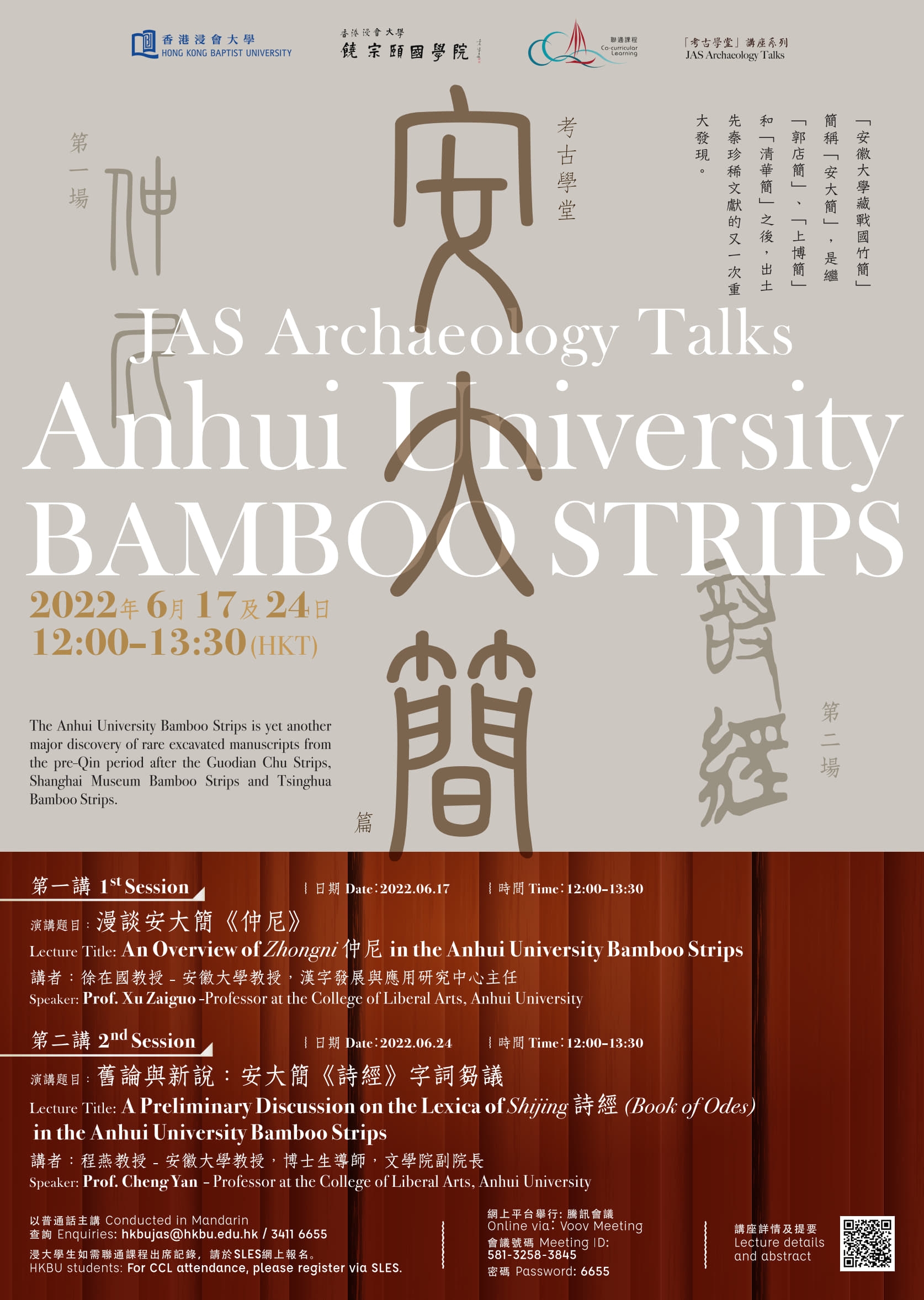
The essence of archaeology is to reconstruct the ancient ways of life from the perspective of material culture. As we know, Sinology is a far broader discipline than textual studies, but beneath it all lies a curiosity and imagination to human conditions in the past. The Academy therefore launched the new “Archaeology Seminar Series” in 2018 to expand its research profile in the direction of Chinese Archaeology. We are currently curating a series of talks on major archaeological discoveries in recent decades, such as the archaeology of Early China, the splendid Bronze Age culture of Sanxingdui, excavated manuscripts of the Qin and Han periods, the Zoumalou official documents and records of the Three Kingdoms period, and gold and silver wares of the Tang dynasty, making this expert knowledge accessible to the public.
Revered as the “national treasure”, the Warring States bamboo slips are one of the rare manuscripts from the pre-Qin period. Acquired in 2015, Anhui University's collection of the Warring States bamboo strips mainly consists of Shijing 詩經 (Book of Odes), history of the ancient state of Chu 楚, Confucian quotations and Confucian writings, Chu Ci 楚辭 (Songs of Chu), oneiromancy and physiognomy. The Anhui University Bamboo Strips is yet another major discovery of rare excavated manuscripts from the pre-Qin period after the Guodian Chu Strips, Shanghai Museum Bamboo Strips and Tsinghua Bamboo Strips. The Academy has therefore invited two professors from the Development and Applied Research Center of Anhui University to lead a discussion on the Confucian quotations and Shijing 詩經 (Book of Odes) in the Anhui University Bamboo Strips. Below are the details of the seminars:
First Session
Date 17 June 2022 (Friday)
Time: 12:00nn-13:30pm
Venue: Tencent Meeting/VooV Meeting
Language: Mandarin
Moderator: Prof. Chen Zhi (Director, HKBU Jao Tsung-I Academy of Sinology)
Lecture title: An Overview of Zhongni 仲尼 in the Anhui University Bamboo Strips
Speaker: Prof. Xu Zaiguo (Professor at the College of Liberal Arts, Anhui University)
Summary (Recorded by Guo Qianmeng):
安徽大學徐在國教授在其題為「漫談安大簡《仲尼》」的講座中,以2015年1月入藏安徽大學的戰國早中期(約公元前400年到前350年之間)竹簡的基本概要為導入,首先大體介紹了安徽大學對於這批「安大簡」鑒定、整理、清洗、編號等具體入藏過程的情況,以及相關工作人員後續研究工作的進行。
第二部分,徐在國教授主要通過圖片形式展示了「安大簡」中《仲尼》簡的具體情況及其珍貴價值。《仲尼》簡由十三隻完整竹簡組成,簡文頂格書寫,書法精美,所載文本內容原無篇題,不分章,均為孔子言論,其中有八處可一一對應至今本《論語》的各篇中。隨後,徐教授對《仲尼》相關內容展開了具體的文本釋讀。
徐教授從音韻、訓詁、文字結構等解讀角度,分別列舉了《仲尼》簡文最後一句「中尼之耑1」中「耑1」一詞的含義的不同闡釋,給予了聽眾更多的可探討空間。隨後,徐教授又以部分《仲尼》簡中的內容與相關傳世文本進行比對,例如今本《論語·雍也》中「一瓢飲」之語在「安大簡」中作「一勺2」,徐教授隸定認為該字為「3」字,是「漿」字的異體,意即飲也,而在《孔子家語·致思》篇中則亦有「一壺『漿』」的用法。
最後的總結部分,徐教授通過前述的諸多例證,再次強調了裘錫圭先生在中國古典學重建體系中的重要論斷,即研究者在對新出土的簡帛文字釋讀時與相對應的傳世本進行對讀的重要性。
注1:
注2:
注3:
Second Session
Date: 24 June 2022 (Friday)
Time: 12:00nn-13:30pm
Venue: Tencent Meeting/VooV Meeting
Language: Mandarin
Moderator: Dr. Adam Craig Schwartz (Associate Director, HKBU Jao Tsung-I Academy of Sinology)
Lecture title: A Preliminary Discussion on the Lexica of Shijing 詩經 (Book of Odes) in the Anhui University Bamboo Strips
Speaker: Prof. Cheng Yan (Professor at the College of Liberal Arts, Anhui University)
Summary (Recorded by Wang Xueting):
2022年6月24日星期五,香港浸會大學饒宗頤國學院「考古學堂」講座系列:安大簡篇第二場講座由安徽大學程燕教授主講,主題為「舊論與新說:安大簡《詩經》字詞芻議」。
會議伊始,程教授講到,安大簡第一冊自2019年公佈,時至今日在學術界仍然非常火熱,仍有很多可挖掘的內容。
首先,程燕教授介紹了安大簡《詩經》的基本情況:三道編繩,簡背有劃痕,簡首尾留白。完簡長48.5,寬0.6釐米。簡正面下部有編號,序號1-117,中間缺失編號:18、19、56、57、58、60-71、95、96、97,實際存簡97支。每支簡不到30字,字數多的接近40字。安大簡《詩經》記錄了國風的內容,包括《周南》11篇、《召南》14篇、《秦風》10篇、《侯風》6篇、《鄘風》7篇、《魏風》10篇,共存《詩》58篇。程教授指出,學術界對《侯風》討論最多,學術界的研究和討論也是在對探索古人最初文本形態做出努力。
其次,程燕教授講到安大簡《詩經》的啟示作用。分別從四點進行了闡述:
一是,有助於準確理解某些詩篇的疑難字詞。如黃天樹先生認爲甲骨文「中 」是一個夜間的時稱,指夜半。
二是,有助於揭示文本流傳中的一些現象。如騶虞,黃德寬先生讀為「縱乎」。
三是,有助於解決古文字考釋的一些疑難問題。譬如:楚帛書甲5.1,包山41等。
四是,有助於我們認識戰國時期古書流傳的概貌。除《周南》、《侯》、《鄘》、《魏》四國風外,簡本未見另兩風的國名。經分析可作出這樣的推測:《召南》和《秦風》本來應都抄寫有國名,因竹簡殘缺而漏失。
五是,豐富了我們對早期文本中符號、標記的認識。簡本符號和標記主要包括章節符號、句讀號、重文號、合文號、省略標記和區別標記。
然後,程燕教授對字詞芻議進行了講解。具體如下:
7. 《周南 關雎》「參差荇菜」(簡1)
8. 《周南 卷耳》「薄污我私」(簡5)
9. 《鄘風 君子偕老》「邦之媛也」(簡89)
10. 《唐風 揚之水》「百世皓皓」(簡104)
11. 《唐風 綢繆》「綢繆束薪」(簡109)
12. 《召南 羔羊》「委蛇委蛇」(簡30)
最後,程教授概括到總結道:簡本保留了很多詞匯的早期形態,對於理解古注有很好的參考價值。